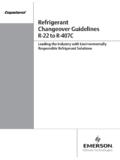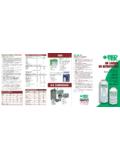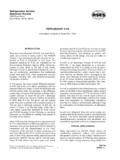Transcription of Alternate Refrigerant Blends and Material Compatibility
1 Santech Technical Information January 1997 Alternate Refrigerant Blends and Material Compatibility with Rubber Materials in Mobile Air Conditioning This test program is a part of on-going research by Santech Industries to determine elastomer Compatibility with new mobile air conditioning refrigerants. All current technical publications are available on our Internet Home Page at 1997 Santech Industries, Inc. All Rights Reserved. Santech Industries, Inc. Phone: 817-589-1212 2450 Handley Ederville Road Fax: 817-589-5900 Fort Worth, TX 76118 Homepage: Industries Alternate Refrigerant Testing Page 2 Executive Summary Many new Alternate refrigerants have been listed as acceptable or pending by the EPA for use in mobile air conditioning systems. The EPA does not look at the function or performance of the new refrigerants.
2 The EPA lists refrigerants based only on environmental and safety concerns. Very little is known on the short-term and long-term effect of these new alternatives on system elastomers and system components yet we have seen an increasing number of installations using these materials. Field reports range from utopia to massive failures. The goal of this test was to develop information on how Santech s materials perform with the new alternative refrigerants. R134a and PAG appears to be the best solution for retrofits where elastomer Compatibility is taken into account. The initial results indicate that the other alternative refrigerants tested are aggressive on the Nitrile and HNBR elastomers. HNBR or Nitrile materials are in almost every mobile air conditioning system. Service Shops or Rebuilders could select a new replacement elastomer to match the alternative Refrigerant but there are many existing elastomers in the air conditioning system that might also need replacement.
3 Hoses could also be effected by the aggressive nature of these refrigerants. Based on the test results to date, Santech recommends the use of R134a instead of any of the alternatives tested in this study because of potential Compatibility problems with existing elastomer seals already in the system. A Compatibility table has been included on the following page to assist with elastomer selection when the use of the alternative refrigerants is desired. Important: Santech s materials have been tested extensively with R12 and R134a, however, the Alternate Refrigerant test results are based on only this one test program. Santech materials were the only materials tested and other materials may or may not react in a similar manner. Santech also has more than one compound that meet many of its internal specifications. This test only tested the Compatibility of one compound out of each type of elastomer.
4 Other compounds might react differently with the Refrigerant Blends and lubricants . (Although the data is not complete, field reports to date have confirmed that original equipment elastomers of the same types are attacked in a similar fashion.) Only one Mineral Oil, one Polyalkylene Glycol Oil, and one Polyol Ester Oil was selected for the test. Other oils may or may not react in a similar manner. There is no warranty implied concerning Material Compatibility with any of the Alternate refrigerants tested. Final testing is the responsibility of the user. Trademarks: Some of the names or number designations associated with the refrigerants could be trademarks of their respective Industries Alternate Refrigerant Testing Page 3 Summary of Test Results The table below gives a rating on each elastomer type with the Refrigerant /lubricant combination. This table does not take into effect temperature requirements of the system.
5 Please see the section on temperature while interpreting this data. Refrigerant ST4470 Nitrile O-ring ST7470 HNBR O-ring ST9670 Neoprene O-ring HNBR Lathe Cut Nitrile Lathe Cut R-12 Mineral Oil Good Good Good Good Good R-134a Polyalkylene Glycol Oil Good Good Good Good Good Freez-12 Mineral Oil Good Marginal Good Marginal Good Freez-12 Polyol Ester Oil Poor Poor Marginal Poor Marginal RB-276 (Freezone) Mineral Oil Marginal Marginal Good Marginal Good FR-12 (Frig-c) Mineral Oil Marginal Poor Good Poor Marginal FR-12 (Frig-c) Polyol Ester Oil Good Marginal Good Poor Good GHG-X4 (Chill-it) Mineral Oil Poor Poor Marginal Poor Poor Hot Shot/Kar Kool Mineral Oil Marginal Note 1 Marginal Note 1 Good Note 1 Poor Note 1 Good Note 1 R-406a (McCool) Mineral Oil Good Poor Marginal Poor Good Good = Volume Change 15% Marginal = Volume Change +16 to +40 Poor = Volume Change >40% Note 1: The Hot Shot container received through retail channels contained only R-22 & R-142b.
6 There is no warranty implied concerning Material Compatibility with any of the Alternate refrigerants tested. Use at your own risk. HNBR and Nitrile are used predominately in air conditioning systems worldwide and were not generally compatible with the Alternate refrigerants. Neoprene performed better with some of the Blends but does not offer the high temperature characteristics that some high side applications require. Although the data is not complete, field reports confirm that original equipment elastomers of the same types above are attacked in a similar fashion. Always consider that an automobile originally designed with certain types of elastomer seals and hoses could have been serviced with other types. It is important to understand what types of seals and hoses are throughout the system or there could be a Compatibility problem. Santech Industries Alternate Refrigerant Testing Page 4 Types of problems reported that caused failure Calls to service facilities that have charged systems with these Alternate refrigerants have mixed results.
7 The reports range from catastrophic to successful systems even with the same Refrigerant . The types of seal and hose failures on the unsuccessful sytems are listed below: Seals swelling where they would no longer fit into the glands Seals splitting open Seals extruding between metal gland surfaces Seals turning into a gum type Material Hoses leaking throughout the length of the hose Hoses collapsing on the suction side due to softening Variables that could affect the results Type of Alternate Refrigerant used Types of elastomer materials in the system that will not be replaced Types of replacement elastomer materials Hose types and age Lubricant used with the Refrigerant Santech Industries Alternate Refrigerant Testing Page 5 Test Overview: This study is to determine the short-term effects of the alternative refrigerants on the elastomers supplied by Santech. Purpose: The elastomer Compatibility test program studied each new Refrigerant with its recommended type of lubricant and their combined effect on elastomers.
8 This study focused on what new replacement elastomers could be used during the service or rebuilding of a system using the new alternative refrigerants. Scope: The study was broken into two types of tests. The first test studied refrigerants, Refrigerant /lubricant combinations, and their effect on elastomers. The elastomers were immersed in the lubricant inside a pressurized test vessel containing the Refrigerant . The physical properties of the elastomers were measured before and after each test. The second test studied the lubricants and their effect on the elastomers in a fluid aging test. Elastomers that are currently in an air conditioning system prior to retrofiting which have been exposed to the previous R12 and mineral oil environment could react differently to the new Refrigerant /lubricant combinations than new elastomers. Other testing programs by other organizations or future Santech programs will determine the effects of the alternatives on elastomers in the system prior to retrofitting the vehicle.
9 Although existing system materials were not specifically targeted, the agressive nature of the new refrigerants on Nitrile & HNBR seals seems to indicate a potential Compatibility problem. Description of the Tests Identified Test Variables Refrigerants: R-12 R-134a FR-12 (Frig-c) RB-276 (Freezone) GHG-X4 (Autofrost/Chill-It) Hot Shot/Kar Kool Freez-12 Ikon-12 (testing later) R-406a (GHG/McCool) GHG-HP (testing later) lubricants : Generic Mineral Oil (MO) Generic Polyalkylene Glycol Oil (PAG) Generic Polyol Ester Oil (ESTER) Elastomers: Santech Green ST7470 HNBR o-rings Santech Black ST4470 NITRILE o-rings Santech Blue ST9670 CR o-rings Santech Black HNBR lathe cuts Santech Black NITRILE lathe cuts Procedures for Refrigerant & Refrigerant /Lubricant Testing Elastomer testing will be performed for 70 hours @ 100C in stainless steel test vessels. Follow the basic procedure for ASHRAE 97 with the following modifications.
10 There will be a separate test vessel for each Refrigerant /lubricant combination. Each Refrigerant , in its pure state without lubricant, will also have a vessel test. Each different type of elastomer will be immersed in a separate vessel. No metal coupons are enclosed. Elastomer specimens are undistorted and in triplicate inside each tube. Volume change, weight Santech Industries Alternate Refrigerant Testing Page 6 change, change in tensile, change in elongation, and hardness change will be recorded for each elastomer. Procedures for Lubricant Testing Elastomer testing will be performed for 70 hours @ 100C in test tubes per ASTM D471 (in combination with ASTM D1414 for o-rings and lathe cuts). Each different elastomer will be immersed in a separate tube of lubricant. Elastomer specimens are in triplicate inside each tube. Each control lubricant will be tested with each elastomer.





